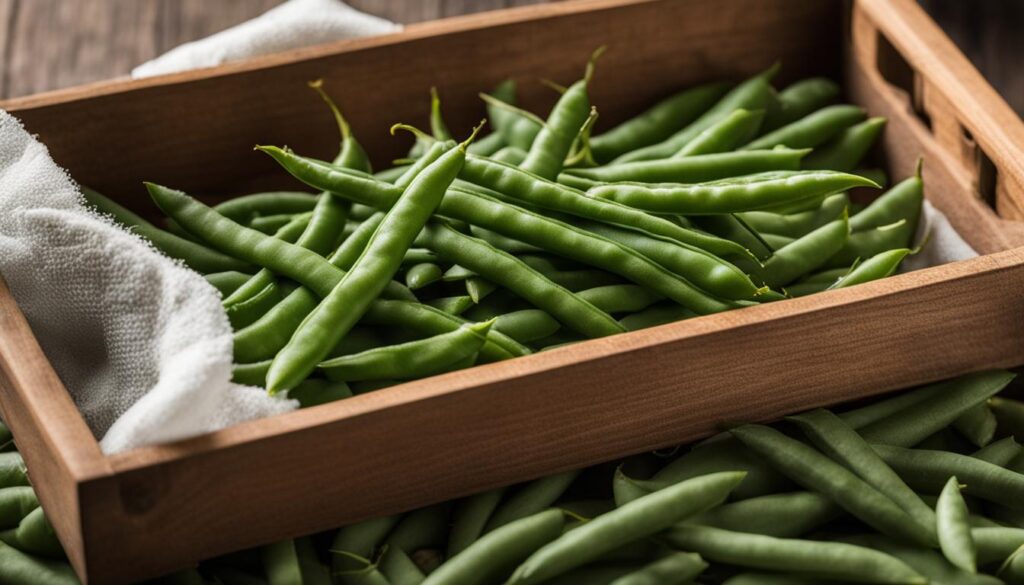Have you ever come across brown spots on your green beans? These spots can be a cause for concern, as they might indicate spoilage. It’s essential to understand what causes these brown spots and how to prevent them to ensure the freshness and quality of your green beans.
When it comes to green beans, visual cues play a crucial role in determining their freshness. Discerning the color and texture of the beans, as well as checking for mold or an off smell, can help you identify if they have gone bad. It’s important to stay vigilant and keep an eye out for any signs of spoilage.
Proper storage practices can significantly extend the shelf life of your green beans. Storing them in the refrigerator and using perforated plastic bags allows for proper airflow, keeping them fresh for up to five days. If you plan to freeze your green beans, blanching them before freezing can help maintain their quality for up to eight months.
In addition to being a delicious addition to meals, green beans also offer a range of health benefits. They are a good source of protein, fiber, and essential vitamins, making them an excellent choice for a nutritious diet.
By understanding the causes of brown spots on green beans and implementing proper storage and handling techniques, you can ensure that your green beans stay fresh, flavorful, and free from spoilage. So, let’s dive into this article and discover effective preventive measures to keep those brown spots at bay!
Signs of Bad Green Beans
When it comes to green beans, freshness is key. To ensure you’re getting the best quality beans, it’s important to be aware of the visual cues that indicate spoilage. Here are the signs to look out for:
- Discoloration: Fresh green beans should have a vibrant, uniform green color. Any brown spots or rust on the beans can be a clear indication that they have gone bad.
- Leaves: Don’t forget to inspect the leaves of the green beans as well. Brown spots on the leaves can be a sign of deterioration.
- Smell: Fresh green beans should have a slightly sweet, grassy scent. If they give off a sour or unpleasant odor, it’s a strong indication that they have spoiled.
- Texture: To assess the texture of green beans, give them a gentle squeeze. They should feel firm and snap easily when bent. If they feel limp, slimy, or mushy, it’s a sign that they are no longer fresh.
By paying attention to these visual cues, you can easily identify if your green beans are still good to use or if they have gone bad. Remember, it’s always better to be safe than sorry when it comes to your food.
Now that you know how to spot signs of bad green beans, it’s time to learn about proper storage and handling techniques in the next section.
Proper Storage and Handling of Green Beans
To prolong the freshness of green beans, it’s important to store them properly. Follow these tips to ensure your green beans stay fresh and flavorful for longer:
- Use the right bag: Fresh green beans should be stored in a perforated plastic bag or a regular plastic bag with small holes to allow for airflow. This helps prevent moisture buildup and spoilage.
- Avoid washing until ready to use: It’s best not to wash green beans until you are ready to cook or eat them. The moisture from washing can promote spoilage.
- Refrigerate for up to 5 days: Place the green beans in the refrigerator to keep them fresh. They can typically be stored in the refrigerator for up to 5 days.
- Extend shelf life by freezing: If you want to store green beans for a longer period, blanch them before freezing. Blanching helps preserve their flavor, texture, and color. Simply blanch the green beans in boiling water for a couple of minutes, then transfer them to an ice bath to cool. Drain well and pack them into airtight freezer bags or containers. Frozen green beans can last up to 8 months in the freezer.
Properly storing cooked green beans is equally important:
- Cool before storing: Allow cooked green beans to cool to room temperature before transferring them to storage containers. This prevents moisture buildup and helps maintain their texture.
- Choose airtight containers: Store the cooked green beans in airtight containers in the refrigerator to keep them fresh and prevent any cross-contamination with other foods.
- Consume within 4 days: Cooked green beans can be stored in the refrigerator for up to 4 days. Beyond that, their quality may start to degrade, so it’s best to consume them within this time frame.
By following these storage and handling tips, you can enjoy the freshness of green beans for an extended period. Whether you’re planning to cook with them or enjoy them as a side dish, proper storage ensures that your green beans retain their flavor and nutritional value.
Conclusion
In conclusion, brown spots on green beans can be a sign of spoilage. By paying attention to visual cues such as discoloration, texture, and smell, you can easily determine if your green beans have gone bad. It is crucial to store and handle your green beans properly to prolong their freshness and prevent brown spots.
One effective way to store fresh green beans is to place them in a perforated plastic bag or a regular plastic bag with small holes. Avoid washing them until you are ready to use them, as moisture can promote spoilage. Refrigerate your green beans for up to 5 days to maintain their freshness.
If you want to extend the shelf life of your green beans, blanching them before freezing is a great option. This process involves briefly boiling the green beans, then rapidly cooling them in ice water. Once blanched, store them in airtight freezer bags or containers, and they will stay good for up to 8 months.
Remember, green beans are not only delicious but also offer numerous health benefits. They are rich in protein, fiber, and essential vitamins. By knowing how to identify and prevent brown spots on your green beans, you can ensure that they stay fresh, crunchy, and appetizing for longer periods.
How Can I Prevent Brown Spots on My Green Beans Like I Would Cut A Guava?
To prevent brown spots on your green beans like you would cut a guava fruit at home, ensure proper ventilation and dryness. Store the beans in a cool, dry place and avoid moisture buildup. Additionally, use a gentle touch when handling the beans to minimize bruising and potential spots.









